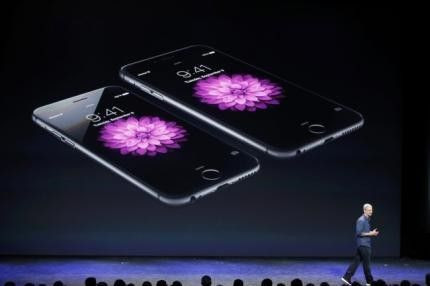iPhone 6 Pre-orders Reach 4 Million: The Next iPhone Could be Solar Powered
Apple Have Patents For Integrated Touch Screen and Solar Panel

Apple released its iPhone 6 and iPhone 6 Plus last September 9 and the Apple iPhone 6 Plus is believed to be sold out. Apple store has crashed and customers are unable to get on the site to pre-order their favourite phone. According to Mac rumours with the increase in the size of the iPhone screens from 3.5 inches to 4 inches Apple had seen a increase in sales in the iPhone 4S from 1 million to 2 millon. Anticipating sales for the iPhone 5, Apple had placed orders for around 68 million phones before the date of release. iPhone was seen the increase in screen sizes from 3.5 inches to 4 inches and now with the release of the iPhone 6 and iPhone 6 Plus the screen size was increased to 4.7 inches and 5.5 inches, respectively. Apple now foresees high gross margins and overall gross profits in sales. Wall Street too is anticipating record sales.
According to the website Fools.com larger screens will surely make Apple iPhone 6 a best seller and the phone will also get rave reviews like it was already getting, however, critics will argue that Apple has lost its innovative touch. To get this innovative touch into the iPhones that will be released in the future Apple could try exploring new technologies.
Solar touch screens
A team lead by Richard Lunt, Assistant Professor of Chemical Engineering and Materials Science at Michigan State University's College of Engineering have invented a solar panel that is absolutely transparent that has the potential to transform anything from windshields in cars, buildings and smartphone screens as well.
This technology is on the basis of the absorption of ultraviolet and infrared light by a thin layer of organic molecules that is very flexible and not visible to the human eyes. This light will be transmitted to a very thin strip of solar panel at the edges of the screen.
These materials are very transparent to the human eyes because they do not absorb or discharge light in the visible spectrum. Because of this characteristic solar energy could be set up in lots of places without any interference. This technology could be used on sky scraper with plenty of windows or any device like the mobile phone, said Professor Lunt.
According to Lunt they have come up with solar harvesting surfaces that nobody will know are there.
At present the technology is still in the beginning stages of development, with 1 per cent efficiency, but Lunt has faith that it can be optimized to 5 per cent and manufactured at a very low cost.
U.K. too is not far behind in this innovation a team lead by Professor David Lidzey at the University of Sheffield are in the process of creating an ultra thin solar panel with a perovskite base that can be spray painted on to any surface including cell phones and cars. This material Perovskite is composed of calcium titanate a substance that is cheap and found globally. Its main characteristic is that it absorbs light in layers 180 times thinner than Silicon resulting in cheaper solar panels.
Apple is quite interested in these innovations and could be trying to patent it. Last May 20, 2014, the U.S. Trademark and Patent Office granted Apple an update to U.S. Patent number 8,730,179 for an "Integrated touch sensor and solar assembly."
Apple had filed for patent in 2008 for integrated touch screen and solar panel to use it to charge batteries and extend battery life. The revised patent is to allow for solar panel to be flexible as well as face into the phone. To generate current, light channels as parabolic mirrors or fibre optics allow for light to be focused on the solar cells.
If Apple uses this technology in their future phone it would not only boost sales, but also take away the stigma that Apple is not into innovation after Steve Jobs. The solar technology if not used by Apple, it will definitely be used by their competitor Samsung in the future.




















